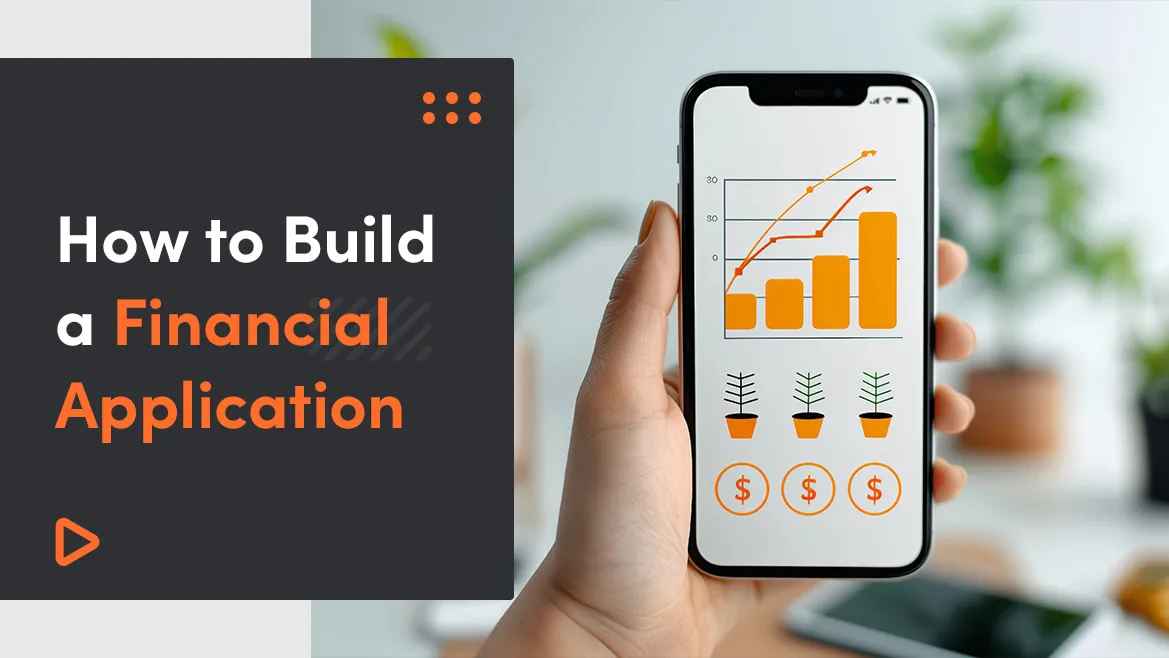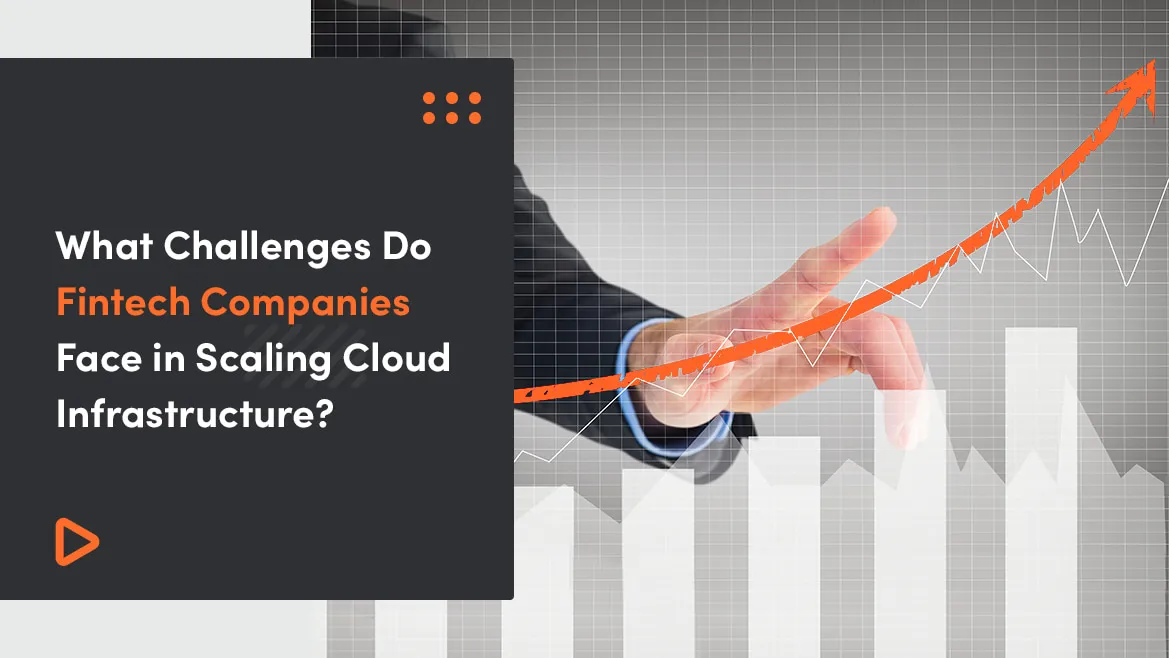Financial technology is in increasingly high demand nowadays. Global revenue from the fintech industry is forecasted to hit €188 billion by 2024, and entrepreneurs are desperate to get in on the action.
Mobile app development is a particularly fertile fintech niche to invest in. However, you need a clear and structured idea of the development process and what you want to achieve. Having your own app can significantly enhance profits and general consumer awareness, but it can easily go wrong.
Keep reading for a comprehensive overview of how to build a successful financial application. Once you understand the basics, our experienced FinTech software developers are on hand to convert your dreams into reality.
What is fintech?
Fintech is an industry term referring to the development of new technological solutions to advance financial services. A portmanteau of financial technology, fintech essentially deals with the application of advanced technology to the banking and finance sectors. This can range from personal finance applications for mobile banking to crypto investment platforms.
Fintech is quickly gaining importance across countless areas.
For example, innovative mobile banking apps make it easier for individuals to track spending and budget effectively. On a more complex level, machine learning and artificial intelligence may be used to deliver more accurate investment predictions or streamline mass payment processing.
Fintech companies are generally startups aiming to leverage new technology to make it easier for businesses or individuals to utilize financial services. Mobile app development is a common way to do so. Applications usually revolve around:
- Online Banking,
- Peer-to-Peer Payments,
- Crowdfunding,
- Investment,
- Mobile Payments,
- Finance Management,
- Crypto Wallets & Trading.
What is a fintech app?

Fintech apps are mobile applications that help businesses or individuals manage their finances and investments via numerous essential features.
PayPal is arguably the most popular fintech app, allowing individuals to easily make online purchases or send and receive money without using traditional online banking. Monzo is another example. The app-based digital banking provider enables easy access to day-to-day financial services without going through traditional banking institutions.
This new breed of fintech app is quickly gaining traction among consumers and investors due to advanced features, slick user interfaces, and lower transaction fees. Building a successful finance app will revolutionize your business model, providing more efficient financial solutions in a dynamic and modern mobile software package.
We’ll outline the benefits, features, and types of fintech app in the sections below:
Benefits of a fintech app
Fintech apps benefit consumers and businesses in various ways.
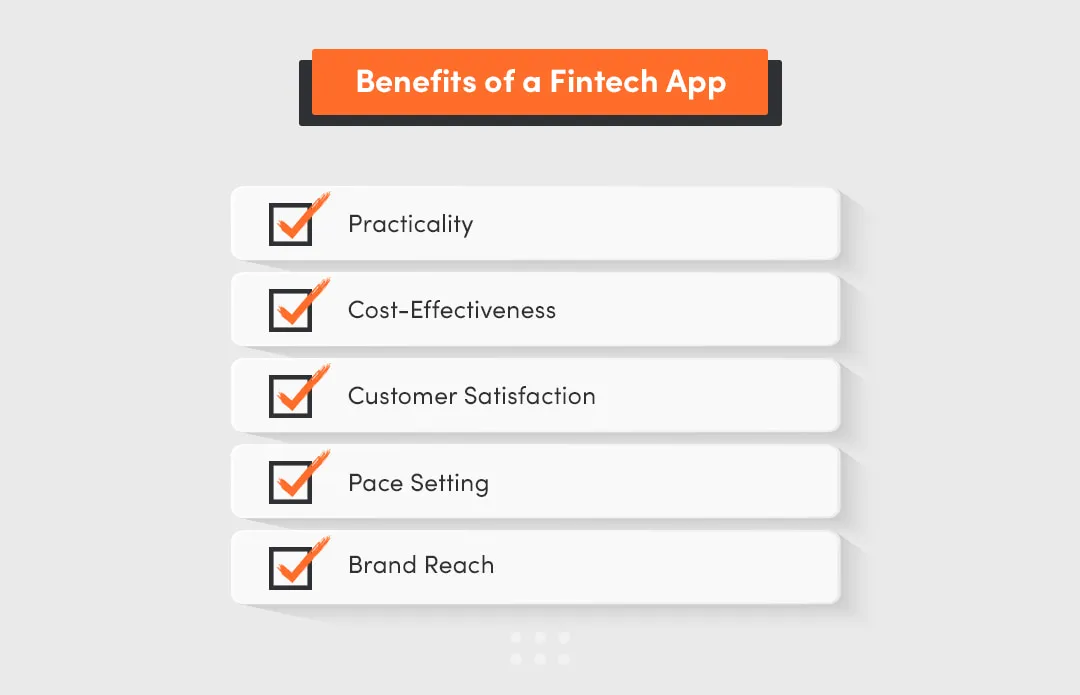
Deviating from the old-fashioned financial services model reaps handsome rewards no matter where you are on the B2C or B2B spectrum. Customers get an overwhelmingly better service, while businesses enjoy high profitability and more efficient working processes.
A few of the key benefits of a fintech app include:
- Practicality: PayPal is a classic example of how important practicality is in the fintech sector. It revolutionized online payments with an extremely slick approach to banking, rapidly gaining a massive worldwide user base. Successful fintech apps offer more intuitive and user-friendly interfaces, ultimately making it far easier to manage personal finances. Consumers can access basic features at the press of a button, negating the clunky interfaces of outdated banking apps.
- Cost-Effectiveness: Fintech apps drive down costs for consumers and businesses by leveraging new artificial intelligence and machine learning technologies. These platforms generally offer low or sometimes non-existent transaction fees for various services, from investing to digital payments. It leads to more money being saved overall and a happy client base.
- Customer Satisfaction: Selleo knows the importance of customer satisfaction, which explains our passion for using new technology to aid consumer happiness. Fintech apps enable users to access financial services more easily, quickly, and cheaply. As a result, businesses can make their customers happier and more loyal, achieving higher ROI and brand longevity.
- Pace Setting: Fintech companies with talented mobile developers under their wing can set the pace via market-leading fintech apps and technology. If your business can offer cutting-edge and advanced features in an attractive app package, it is bound to be a success. Not only this but fintech businesses with world-leading mobile apps (think Monzo or PayPal) will naturally have an edge over competitors in the future.
- Brand Reach: A successful state-of-the-art app will elevate your business with higher profits, but perhaps even more importantly, it will offer unrivalled brand reach. All the most renowned fintech apps have grown through slick branding and word-of-mouth awareness. Once your company has a fashionable mobile app, its name will be ever-present in the fintech world.
Example features of fintech apps
Knowing the expected fintech app features is paramount to continuously setting software development trends within the industry. Making it easy for consumers to manage their finances is the primary goal.
This is achieved via numerous features, including:
- Quick and easy money transfers,
- Budget setting,
- Financial advice and help,
- Credit score tracking,
- Automatic transfers into savings,
- Spending trackers and alerts,
- Straightforward investment tools.
Types of fintech app
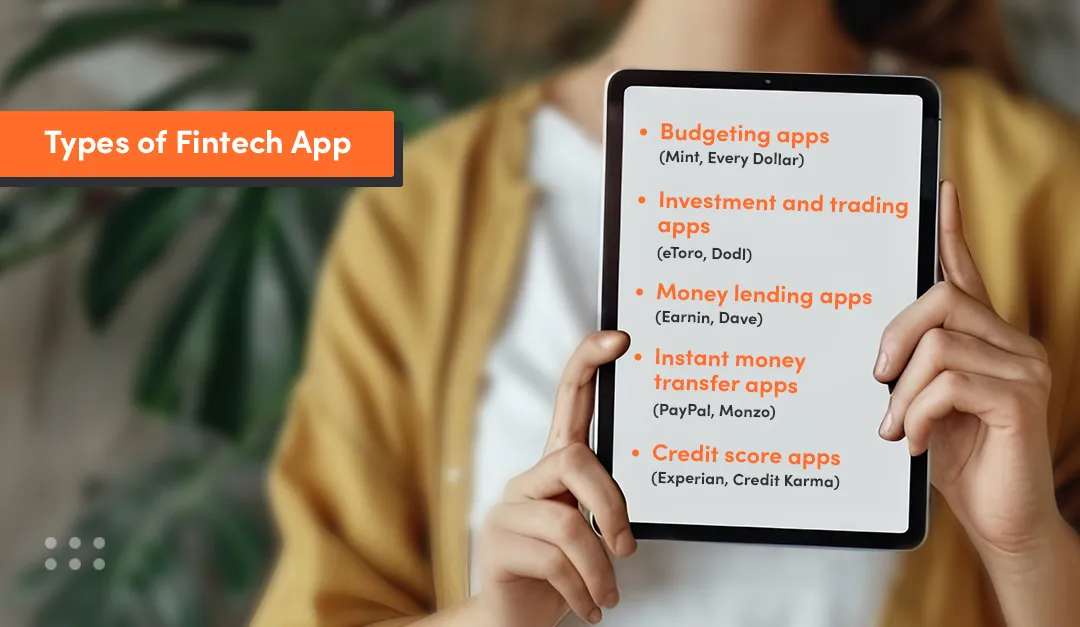
There is a broad spectrum of fintech apps on the market currently. Knowing the different categories is essential to identifying your specific niche or gap in the market, so check out the options below:
- Budgeting apps (Mint, Every Dollar)
- Investment and trading apps (eToro, Dodl)
- Money lending apps (Earnin, Dave)
- Instant money transfer apps (PayPal, Monzo)
- Credit score apps (Experian, Credit Karma)
Try our developers.
Free for 2 weeks.
No risk. Just results. Get a feel for our process, speed, and quality — work with our developers for a trial sprint and see why global companies choose Selleo.
Challenges of developing a fintech app & costs
Businesses must navigate various challenges to build a financial app successfully. Costs can be high, so acquiring enough capital via investors and stakeholders is crucial, especially for startups. Some of the most pressing challenges involved in developing a market-leading fintech app include:
- Regulations: Complying with government regulations is the No. 1 challenge for mobile fintech providers. Your whole business could be under threat, so navigating the complex network of laws and regulations in each territory you offer services is essential.
- Interface: Developing a slick and aesthetically pleasing user interface is another important challenge to overcome. The app needs to be dynamic and user-friendly with a straightforward approach to its core features. Detailed testing and feedback sessions will enhance this.
- Unique Selling Point: Standing out in an increasingly saturated fintech industry is difficult, so your app must have a compelling USP marking it out from the competition. Dedicated market research, forward-thinking software design, and natural creativity are essential here.
- Funding: While they can be extremely profitable long term, fintech startups generally need external investment to get their apps off the ground. Determining your expected ROI and working with efficient mobile developers is key to budgeting and acquiring funds.
- Security: Fintech companies handle sensitive personal data, so mobile apps must have watertight security protocols. This includes customer legal agreements, data privacy policies, insurance programs, and an unhackable backend.
How to develop a fintech app
Developing a fintech app involves several important stages. You will need a clear idea backed by extensive market research alongside market-leading mobile developers like our own at Selleo. We’ll walk you through the process below:
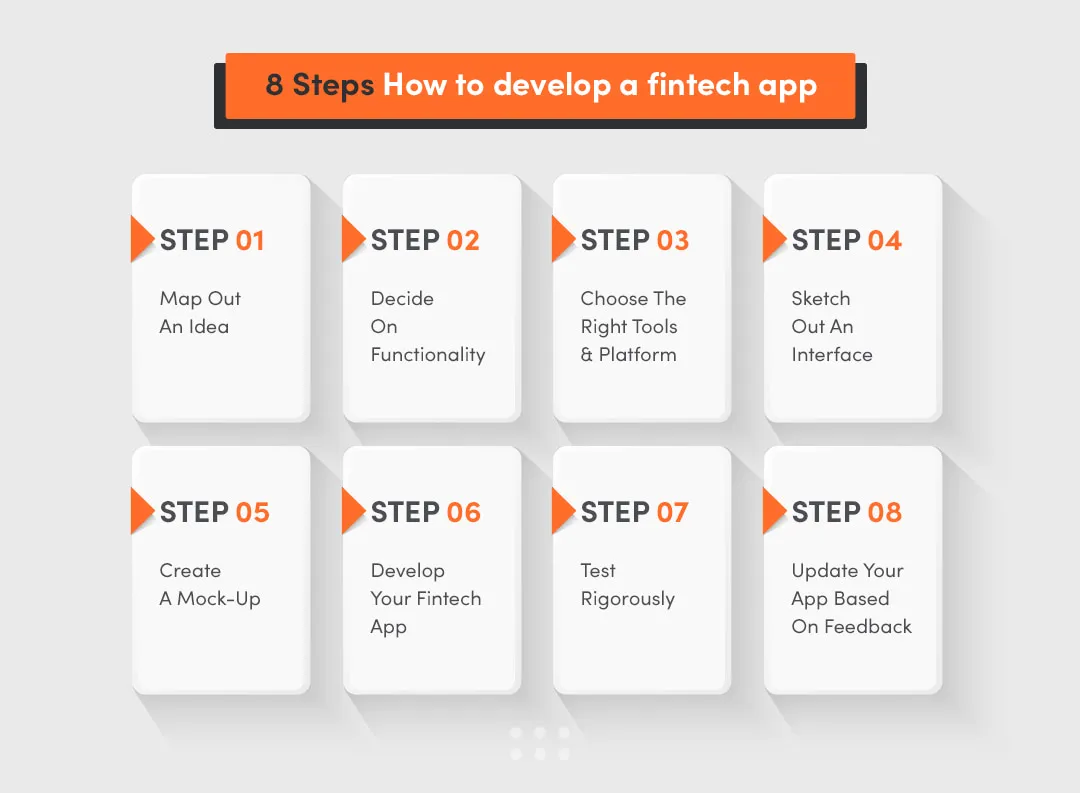
#1: Map Out An Idea
Having a golden idea for a fintech app is key to being successful. Engage in targeted market research and extensive conceptualization sessions. Think creatively and factor in scalability, global reach, and user-trends into your decision-making. Most importantly, create a USP setting you apart from the crowd.
#2: Decide On Functionality
What will your fintech app do? And how will it help consumers as much as possible? Making decisions on functionality is key to generating an early idea of how your app will work. It will also influence marketing decisions further down the line and general brand identity.
#3: Choose The Right Tools & Platform
Choosing the right tools and platform is essential whether you work with an outsourced partner or an in-house development team. Decide between iOS and Android (or opt for both), and choose the most tailored tech stack for your project based on its scope, app architecture, programming languages, and thread detection technologies.
#4: Sketch Out An Interface
Your fintech app’s front end is profoundly important, so make sure you take time sketching out ideas. This is the most creative part of the process, and you can have fun designing an innovative and eye-catching layout. Just don’t lose sight of the common objectives like easy access to basic features and uncluttered composition.
#5: Create A Mock-Up
Once you have decided on an interface and sketched out the basics, you’ll need to create a realistic mock-up of each screen of your financial app. This will determine whether your ideas translate into reality and help you visualize navigating through the app as a user.
#6: Develop Your Fintech App
Now the foundations are set, you can start the app development process. Decide between an in-house development team (if available) or outsourcing to an experienced software development company with proven experience like Selleo.
#7: Test Rigorously
Testing is the best and most efficient way to finetune your fintech app before mass release. This is where you can iron out any creases and focus on making the user intuitive as friendly and rewarding as possible. Build an MVP version of your app for early release to a select group of users. Not only does this give you valuable user data, but it also generates a core usership before the full launch.
#8: Update Your App Based On Feedback
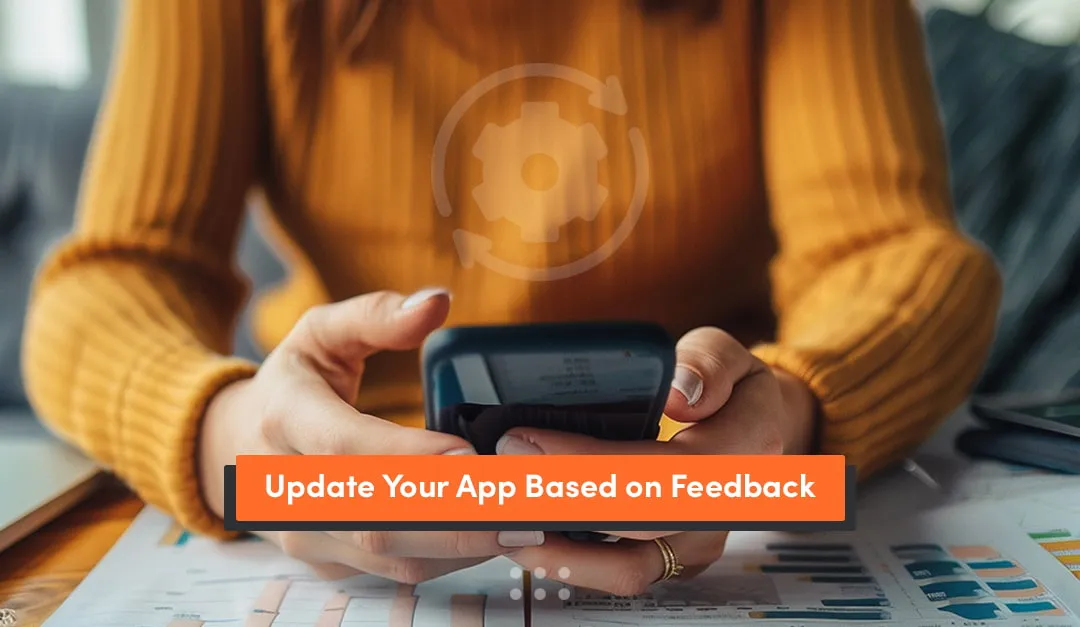
Updating your mobile app consistently is crucial throughout the testing and launch periods. Listen to consumer feedback and implement changes accordingly. The job doesn’t simply end after launch. You’ll need to actively keep your app right at the cutting-edge to ensure long-term success.
What functions should be implemented in a financial application?
User Authentication and Security Features
- Secure Login: Multi-factor authentication (MFA), biometric login (fingerprint, face recognition), and strong password enforcement are crucial for protecting user data.
- Data Encryption: End-to-end encryption ensures that all sensitive information (personal details, transaction data) is securely transmitted.
- Fraud Detection: Implementing AI-driven fraud detection to identify and flag suspicious activities helps protect users from unauthorized transactions.
Account Management
- User Profiles: Users should be able to create and manage their profiles, including updating personal information and setting preferences.
- Multiple Account Integration: The app should support linking multiple bank accounts or credit cards for a holistic view of financial data.
- Transaction History: Display detailed records of all past transactions, including dates, amounts, and recipients, with the ability to filter and search.
Money Transfers and Payments
- Peer-to-Peer Payments: Easy transfers between users via mobile numbers, email addresses, or unique usernames.
- Bill Payments: Integration with utility providers and other services to allow users to pay bills directly from the app.
- Recurring Payments: The ability to set up automatic payments for subscriptions, loans, or regular bills.
- International Transfers: Support for cross-border payments with transparent exchange rates and low fees.
Budgeting and Expense Tracking
- Expense Categorization: Automatically categorize expenses (e.g., groceries, entertainment) and provide users with a breakdown of spending.
- Budgeting Tools: Users can set financial goals or limits for different categories and receive notifications when nearing their budget limits.
- Savings Goals: Tools to help users set and track savings targets for specific goals, such as vacations or emergency funds.
Investment Management
- Portfolio Tracking: Users can monitor and manage their investment portfolios, view real-time data, and track performance over time.
- Stock Trading: Integration with stock exchanges to allow users to buy, sell, and track stocks, bonds, or other assets.
- Cryptocurrency Integration: The ability to manage and trade cryptocurrencies, with real-time data on market trends.
Loan and Credit Management
- Credit Score Monitoring: Provide users with access to their credit scores and give insights on how to improve them.
- Loan Applications: A streamlined process for applying for personal or business loans directly through the app.
- Debt Management Tools: Users can track their loans, view repayment schedules, and receive reminders for upcoming payments.
Notifications and Alerts
- Real-Time Alerts: Push notifications for important events, such as low balances, incoming payments, or unusual transactions.
- Reminders: Alerts for upcoming bill payments, loan due dates, or investment opportunities.
- Customized Notifications: Allow users to set preferences for the type of alerts they wish to receive (e.g., daily balance updates, large transaction alerts).
Personalized Financial Insights
- AI-Powered Insights: Use machine learning to analyze user spending habits and provide personalized recommendations for saving money or optimizing investments.
- Financial Health Dashboard: A summary view of the user's overall financial health, including net worth, cash flow, and debt levels.
- Cost-Saving Suggestions: Based on transaction history, the app can suggest ways to cut unnecessary expenses or consolidate debt.
Customer Support
- Live Chat Support: Integration of AI chatbots and live agents to provide immediate help for user inquiries.
- Help Center: A knowledge base with FAQs, tutorials, and articles to assist users in navigating the app.
- Dispute Resolution: A process to report and resolve transaction disputes or incorrect charges.
Integration with Third-Party Services
- Open Banking APIs: Integration with third-party apps and services via APIs to allow users to access additional financial tools, such as tax preparation or economic advisory services.
- Digital Wallet Integration: Compatibility with popular digital wallets (e.g., Apple Pay, Google Pay) for easy mobile payments.
- Accounting Software Integration: For business users, seamless integration with accounting software (e.g., QuickBooks, Xero) to manage expenses and revenues.
Tax Management
- Expense Tracking for Tax Filing: Users can categorize and export expenses for tax purposes.
- Tax Filing Assistance: Integration with tax preparation tools or services to help users file taxes efficiently.
Loyalty and Rewards Programs
- Cashback Offers: Allow users to earn cashback rewards for certain purchases or transactions.
- Loyalty Points Tracking: Enable users to track and redeem loyalty points earned through spending on specific services or products.
Multi-Language and Multi-Currency Support
- Localization: Offer multi-language support for global users.
- Currency Conversion: Automatic currency conversion with real-time exchange rates for users making international transactions.
Financial Education and Content
- Educational Content: Provide users with articles, videos, or tools to enhance their financial literacy.
- Financial Tips: Regularly offer advice on saving, investing, or debt management based on user behavior.
By implementing these functions, a financial application can provide a comprehensive and user-friendly experience that meets the diverse needs of both individual and business users while ensuring security and reliability in all transactions.
Summary
Building a successful FinTech mobile application is complex and challenging, but the rewards can be substantial. Fintech is one of the fastest growing industries worldwide, and a revolutionary app is the best way to enter the market. These applications offer unrivalled practicality, advanced features, and cost-effectiveness for businesses and consumers.
Selleo is a trusted global partner in mobile software development, with a dedicated fintech development team leveraging new technology to advance fintech-specific software solutions. We can help you build a successful financial application from planning to implementation.
Building a Fintech app requires a clear understanding of financial regulations, including compliance with local and international laws such as GDPR and PSD2. Security is paramount, so the app must incorporate robust encryption, multi-factor authentication, and other cybersecurity measures to protect sensitive user data. A seamless user experience (UX) is crucial, requiring intuitive design and smooth integration with existing financial systems, like banks and payment gateways. Collaboration with financial institutions or obtaining necessary licenses is often required, depending on the app's services. Finally, scalability should be considered from the outset to handle growth in users and transactions effectively.
AI is increasingly essential in fintech due to its ability to enhance security, such as detecting fraud through real-time analysis of transaction patterns. It also improves customer service by enabling chatbots and virtual assistants to handle routine inquiries quickly and efficiently. AI-driven analytics help financial institutions offer personalized financial advice and products tailored to individual user behaviors. Additionally, AI enhances risk management by predicting potential market shifts or credit risks. Overall, AI helps fintech companies stay competitive by improving efficiency, decision-making, and user experience.
The development of a fintech app typically takes between 6 to 12 months, depending on the complexity and specific features required. This timeline includes the stages of planning, design, development, testing, and regulatory compliance checks. Building secure and compliant features like payment processing, user authentication, and data protection can extend the timeframe. Integration with third-party services, such as banks or payment gateways, often requires additional time for proper coordination and testing. Ongoing updates and improvements may continue even after the app’s initial launch.
